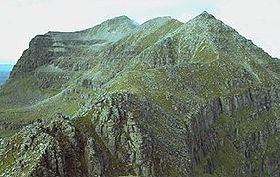Liathach
| Spidean a' Choire Lèith | |
|---|---|

Looking west along Liathach
|
|
| Highest point | |
| Elevation | 1,055 m (3,461 ft) |
| Prominence | 957 m (3,140 ft) Ranked 8th in British Isles |
| Parent peak | Càrn Eige |
| Listing | Marilyn, Munro |
| Naming | |
| Translation | Peak of the Grey Corries (Gaelic) |
| Pronunciation | Scottish Gaelic: [ˈs̪pitʲan ə ˈxɔɾʲə ˈʎeː] |
| Geography | |
| Location | Torridon, Scotland |
| OS grid | NG929579 |
| Topo map | OS Landranger 25 |
| Listed summits of Liathach | ||||
| Name | Grid ref | Height | Status | |
|---|---|---|---|---|
| Mullach an Rathain | NG912577 | 1023 m (3,356 ft) | Marilyn, Munro | |
| Meall Dearg | NG913579 | 955 m (3133 ft) | Munro Top | |
| Stob a' Choire Liath Mhòr | NG932581 | 983 m (3225 ft) | Munro Top | |
| Am Fasarinen | NG923574 | 927 m (3041 ft) | Munro Top | |
| Stùc a' Choire Dhuibh Bhig | NG942582 | 915 m (3002 ft) | Munro Top | |
Liathach is one of the most famous of the Torridon Hills. At a height of 3,461 feet (1,055 m), it lies to the north of the A896 road, in the Northwest Highlands of Scotland, and has two peaks of Munro status: Spidean a' Choire Lèith at the east of the main ridge, and Mullach an Rathain at the western end of the mountain. The name Liathach is pronounced [ˈʎiə.əx] in Scottish Gaelic, and means 'The grey one'. Liathach conveys an aura of impregnability when seen from the roadside below, as the slopes appear to rise up in a series of near vertical rocky .
The mountain is composed of Torridonian sandstone which forms massive near-horizontal strata. They form the numerous terraces that are obvious from afar. The rocks are mainly red and chocolate sandstones, arkoses, flagstones and shales with coarse conglomerates locally at the base. Some of the materials of these rocks were derived from the underlying Lewisian gneiss, upon the uneven surface of which they rest, but the bulk of the material was obtained from rocks that are nowhere now exposed. Upon this ancient denuded land surface the Torridonian strata rest horizontally or with gentle inclination. Some of the peaks, such as Beinn Eighe, are capped with white quartzite, giving them a distinctive appearance when seen from afar. Some of the quartzite contains fossilized worm burrows and is known as pipe rock. It is circa 500 million years old. The Torridon landscape is itself highly denuded by glacial and alluvial action, and represents the remnants of an ancient peneplain.
...
Wikipedia
